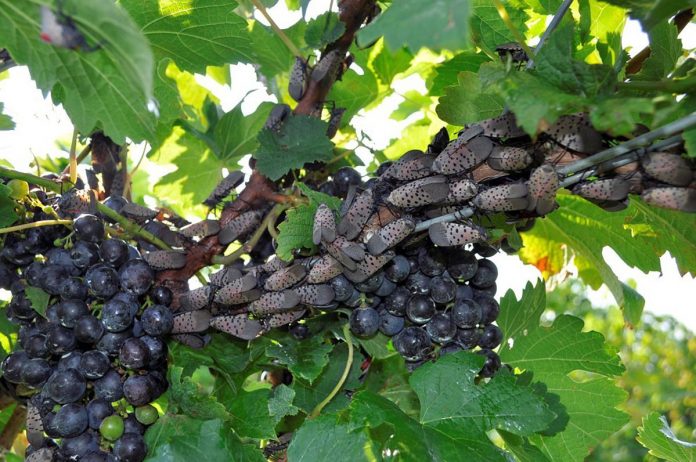UNIVERSITY PARK, Pa. — Many people dread the thought of cold temperatures and snowy days to come. Yet, for some folks living in the southeastern part of Pennsylvania, Old Man Winter cannot come soon enough.
That will give them a reprieve, albeit a brief one, from the spotted lanternfly, an invasive pest that has marred their spring and summer outings.
“The spotted lanternfly has become a regular fixture in their yards, on the front page of their newspapers, in their social media feeds and, sometimes, even in their dreams,” said Heather Leach, Penn State’s spotted lanternfly Extension associate, who has fielded calls from hundreds of homeowners in the current 13-county quarantine zone.
“They just cannot get a break.”
The pest, which feeds on the sap of fruit trees, grapevines, hops, hardwoods and ornamentals, strikes a double whammy — not only does it harm host plants but it also can render outdoor areas unusable by leaving behind a sugary excrement called honeydew, which attracts other insects and promotes the growth of sooty mold.
The only consolation is that the insects do not bite or sting, nor do they cause structural damage.
Despite not being a native species (they are native to central Asia), the climate in Pennsylvania is suitable for the spotted lanternfly, and it has established a life cycle that completes one generation each year.
Lifecycle
It all begins now, in late summer, when adults mate and lay eggs — gray-colored, flat clusters that resemble mud — on a variety of surfaces. While those adults do not survive the winter, the same does not hold true for their egg masses, which are hardy enough to withstand brutal weather conditions.
Those eggs hatch in late spring, revealing nymphs with black and white spots. As they enter their “teens,” most of the insect’s black markings will turn red.
By mid-summer, the insects will be adults, measuring about an inch in length and sporting artfully patterned wings of red, black, white and tan, accented by dots.
Throughout the transformation, one thing remains constant — their voracious appetite, and that has homeowners scrambling to find ways to control the clusters that have taken up residence on their properties.
Stop the spread. Leach asks all citizens to help stop the insect’s spread by checking their vehicles closely — undercarriages, windshield wipers, wheel wells, luggage racks and such — for spotted lanternflies and egg masses before traveling in and out of the quarantine zone.
“Keeping the spotted lanternfly from reaching other parts of the state is crucial while we work toward developing long-term management and control solutions,” she said.
How to stop the spread of lanternflies
To aid homeowners in reducing spotted lanternfly populations, here are some recommendations based on life cycle and season:
Destroy egg masses/fall, winter and spring
Walk around your property to check for egg masses on trees, cement blocks, rocks and any other hard surface. If you find egg masses on your property from September to April, scrape them off using a plastic card or putty knife, and then place the masses into a bag or container filled with rubbing alcohol or hand sanitizer. This is the most effective way to kill the eggs, but you also can smash or burn them.
Tree banding/spring and summer
When the nymphs first hatch, they will walk up the trees to feed on the softer new growth of the plant. Penn State Extension expert Heather Leach advises taking advantage of this behavior by wrapping tree trunks in sticky tape and trapping the nymphs.
She also recommends checking the traps on a regular basis because, while rare, birds and small mammals can become stuck to the tape. There are several ways to avoid this unfortunate outcome, including reducing the width of the bands and putting caging over the bands. Bands can be purchased from hardware or greenhouse stores and often are sold as flypaper.
Removal of tree-of-heaven/spring and summer
While the spotted lanternfly will feast on a variety of plant species, they have a special fondness for Ailanthus, or tree-of-heaven, which is an invasive plant that is common in landscape plantings, agricultural areas and along the sides of roads. For this reason, there is a current push from spotted lanternfly experts to remove this tree.
Leach said the best way to do this is to apply an herbicide to the tree using the hack-and-squirt method — a critical step to prevent regrowth — and cutting it down from July to September. Even when treated, multiple applications may be necessary over time to kill the tree.
Use of insecticides/spring, summer and fall
When dealing with large populations of the insect, homeowners may have little recourse other than to use chemical control. When used appropriately, insecticides can be an effective and safe way to reduce lanternfly populations.
Penn State Extension currently is researching which insecticides are best for controlling the pest, but preliminary results show insecticides with the active ingredients dinotefuran, imidacloprid, carbaryl and bifenthrin are most effective. However, there are safety, environmental and sometimes regulatory concerns that go along with the use of insecticides, so Leach advises homeowners to do research, weigh the pros and cons, and seek professional advice if needed.
She warned against the use of home remedies such as cleaning and other household supplies as they can be unsafe for humans, pets, wildlife and the plants. In some cases, the application of home remedies may be illegal.
Those steps, as well as a detailed integrated pest management calendar, can be found by visiting the Penn State Extension website at https://extension.psu.edu/spotted-lanternfly.











Thank you for this update!